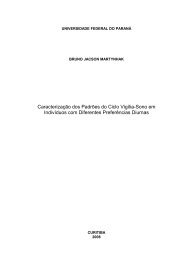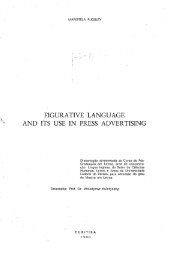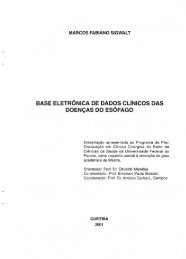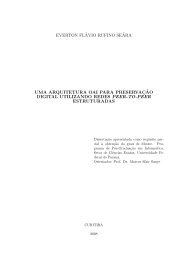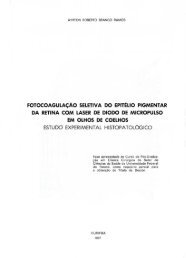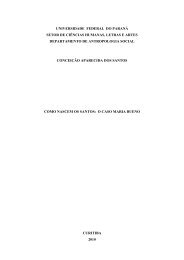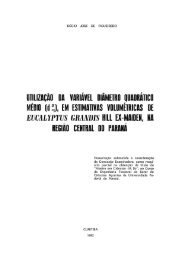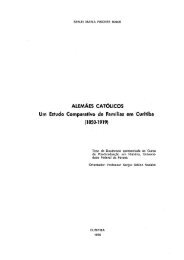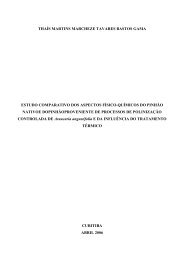towards an analysis of errors made by university students ... - DSpace
towards an analysis of errors made by university students ... - DSpace
towards an analysis of errors made by university students ... - DSpace
You also want an ePaper? Increase the reach of your titles
YUMPU automatically turns print PDFs into web optimized ePapers that Google loves.
25<br />
they usually precede the noun. This subject is elaborated,<br />
with details, in BACK, Eurico & MATTOS, Geraldo. Gramati ca<br />
construtural da língua portuguesa. São Paulo, FT D, 1 9 72 . v. 1.<br />
p. 311-19. What Sinclair calls a nominal group the authors<br />
mentioned above call 'locução subst<strong>an</strong>tiva'. The headword in<br />
their concept is the nucleus (núcleo) in a 'locução subst<strong>an</strong>tiva';<br />
the exponent <strong>of</strong> the nucleus is also a noun; as to the adjectives,<br />
they have been divided in 7 sub-classes according to their<br />
position or function within the 'locução subst<strong>an</strong>tiva ' . From the<br />
examples presented on page 312, <strong>by</strong> BACK & MATTOS, we are<br />
interested in those adjectives that they have called 'qualificativos',<br />
'especificativos' e 'pátrios' because it is their<br />
position in relation to the nucleus that has served as the basis<br />
for this work. Those authors say that the 'especificativos' are<br />
those which occur immediately after the nucleus, or the noun;<br />
the 'pátrios' - the ones concerning nationalities or origin - •<br />
may come immediately after the noun or after the 'especificativos';<br />
the 'qualificativos' are the ones which may come immediately<br />
before the noun or after it; if there are 'especificativos' or<br />
'pátrios' in between, the 'qualificativos' come after the last<br />
adjective(s) after the noun.<br />
It is not our purpose to establish a comparison<br />
between the classes <strong>an</strong>d sub-classes <strong>of</strong> adjectives as presented<br />
<strong>by</strong> BACK & MATTOS <strong>an</strong>d the delicacy scale at (m) as Sinclair has<br />
devised it; we have already seen that there is not a consistent<br />
way <strong>of</strong> classifying the exponents operating at e <strong>an</strong>d n between<br />
the systemic grammar <strong>an</strong>d the constructural one. Our main concern<br />
is to show that our <strong>students</strong> do not detect the headword <strong>an</strong>d<br />
modifiers in <strong>an</strong> English ngp, or if they do so, they are not<br />
able to ch<strong>an</strong>ge (m) to the equivalent element in Portuguese which<br />
operates at (q), besides ignoring the sequence <strong>of</strong> the exponents<br />
in the rendered tr<strong>an</strong>slations which usually present <strong>an</strong> awkward<br />
arr<strong>an</strong>gement, not to mention those cases where comprehension<br />
has been completely obstructed; moreover, we know that the<br />
occurrence <strong>of</strong> some sort <strong>of</strong> adjectives before the noun, in<br />
Portuguese, is due to some stylistic reasons or it may also be<br />
ruled <strong>by</strong> sem<strong>an</strong>tic criteria; on page 315 BACK & MATTOS have<br />
quoted <strong>an</strong> example where the 'colour' adjective may occupy either<br />
(m) or (q) positions giving rise to different interpretations.



